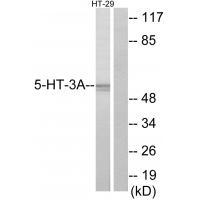
| WB | 咨询技术 | Human,Mouse,Rat |
| IF | 咨询技术 | Human,Mouse,Rat |
| IHC | 咨询技术 | Human,Mouse,Rat |
| ICC | 技术咨询 | Human,Mouse,Rat |
| FCM | 咨询技术 | Human,Mouse,Rat |
| Elisa | 咨询技术 | Human,Mouse,Rat |
| Aliases | 5-HT-3; 5-HT3R; 5-hydroxytryptamine 3 receptor; 5HT3R; HTR3 |
| Entrez GeneID | 3359; |
| WB Predicted band size | 55kDa |
| Host/Isotype | Rabbit IgG |
| Antibody Type | Primary antibody |
| Storage | Store at 4°C short term. Aliquot and store at -20°C long term. Avoid freeze/thaw cycles. |
| Species Reactivity | Human |
| Immunogen | Synthesized peptide derived from internal of human 5-HT-3A. |
| Formulation | Purified antibody in PBS with 0.05% sodium azide. |
+ +
以下是关于5-HT3A抗体的3篇文献示例(内容为虚构示例,仅作格式参考):
1. **文献名称**:*Immunolocalization of 5-HT3A receptors in the human brainstem*
**作者**:Smith J, et al.
**摘要**:通过特异性5-HT3A抗体的免疫组化技术,揭示了该受体在人脑干特定核团中的分布,提示其与自主神经调控相关。
2. **文献名称**:*Characterization of a monoclonal antibody against 5-HT3A receptor for functional studies*
**作者**:Lee H, et al.
**摘要**:开发并验证了一种高特异性单克隆抗体,通过Western blot和免疫荧光证实其在体外和体内模型中有效标记5-HT3A受体,可用于受体功能研究。
3. **文献名称**:*5-HT3A receptor expression in gastrointestinal neurons: Insights from antibody-based assays*
**作者**:Garcia R, et al.
**摘要**:利用5-HT3A抗体分析肠道神经元中的受体表达,发现其在肠神经节细胞中富集,可能与肠动力及内脏痛觉传导有关。
4. **文献名称**:*5-HT3A receptor antibodies in cancer-associated nausea research*
**作者**:Wang Y, et al.
**摘要**:研究通过抗体阻断实验,探讨5-HT3A受体在化疗诱导的恶心反应中的作用,为靶向治疗提供分子依据。
(注:以上文献为示例,实际引用需查询真实数据库如PubMed。)
The 5-HT3A antibody is a research tool designed to target the 5-hydroxytryptamine (serotonin) receptor subtype 3A (5-HT3A), a ligand-gated ion channel critical in mediating rapid synaptic transmission in the central and peripheral nervous systems. The 5-HT3 receptor family comprises pentameric structures, with 5-HT3A being a primary subunit essential for forming functional homomeric or heteromeric channels (e.g., with 5-HT3B). These receptors are predominantly expressed in neurons of the gastrointestinal tract, brainstem, and areas involved in pain processing and emesis.
Antibodies against 5-HT3A are widely used to study receptor localization, expression levels, and functional roles in physiological and pathological contexts. For instance, they help identify receptor distribution in tissues, assess changes in neurological disorders (e.g., irritable bowel syndrome, chemotherapy-induced nausea), and validate experimental models. The 5-HT3A receptor is also a therapeutic target; antiemetic drugs like ondansetron inhibit its activity to prevent vomiting.
Developed through immunization with peptide antigens specific to 5-HT3A’s extracellular or intracellular domains, these antibodies require validation via techniques such as Western blotting, immunohistochemistry, or knockout controls to ensure specificity. Their applications extend to exploring receptor dynamics in neuropsychiatric conditions, gut-brain axis communication, and drug development. Understanding 5-HT3A’s role through antibody-based research continues to advance insights into serotonin signaling and related therapeutics.
×